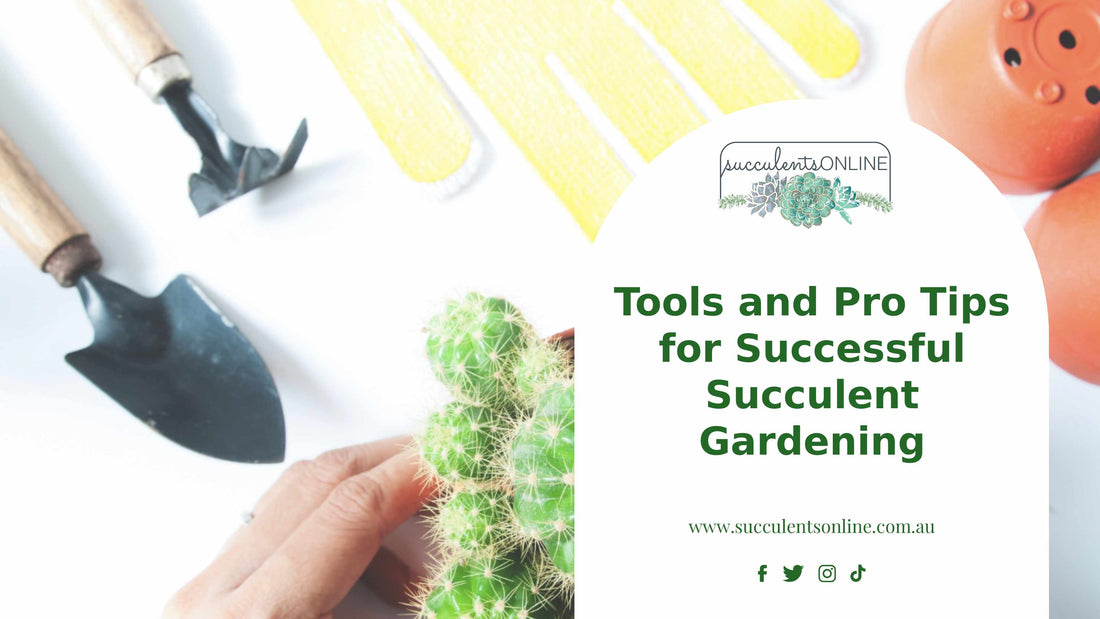
🌵 Essential Tools and Pro Tips for Successful Succulent Gardening in Australia
Are you ready to take your succulent gardening to the next level here in Melbourne or anywhere across Australia?
Your succulent might be silently begging for more attention… or it could be tired of too much care.
When I first started growing succulents, I was obsessed over doing everything perfectly. I gave them sunlight, fertilizer, and water—but still, they withered or stretched oddly. It felt like they were trying to die no matter what I did.
Eventually, I realized the issue wasn’t my lack of effort—it was my understanding. Every succulent has its own rhythm. When you start listening to your plant, it tells you what it needs.
If you're in the same boat, you're not alone—and you're absolutely in the right place.
In this guide, I’ll share the essential tools you need for easy succulent gardening in Australia and expert-level tips tailored for Melbourne gardeners.


🧰 Top Tools for Succulent Gardening in Australia
The first step in succulent care is proper handling. Using the right tools for the job makes a big difference. For example, using a knife instead of shears when shears are required can damage your succulents.
1. Tweezers
If you have succulents, using tweezers to remove dead parts is very helpful. You can use them to get dead leaves out of narrow spaces so the plant doesn’t get damaged. It’s easy to place small succulents precisely and without harm using tweezers during repotting. They’re additionally helpful for getting rid of mealybugs which can hide in the little cracks of succulent leaves.
2. Soft Brush
For cleaning, it’s smart to use a paintbrush or a makeup brush because they are gentle and won’t harm the leaves. Handling these coated succulents lightly is important, so touchless functions can be superior to manual ones.
3. Sharp Scissors or Pruning Shears
For cutting back on dead or excessive portions of the plant, you will need nice, sharp scissors or pruning shears. Having clean cuts stops the spread of disease and stimulates proper growth. You can also use them to propagate, so your cuttings have a good chance of rooting.
4. Watering Can with a Long Spout
With a watering can and a long, narrow spout, you are able to keep the water near the roots of the plant and keep moisture away from the leaves, helping prevent rot.
5. Gloves
While handling succulents is easy for most, I would suggest putting on gloves while tending Agaves and cacti to avoid injury from their spines and sharp edges.
6. Chopsticks or a Use
Cut them into sticks that you can use to plant, breathe into the soil or help hold your plants upright. They let you test the soil to see if it’s dry before adding water.
7. Spray Bottle
A spray bottle works best when you want to gently mist your humidity-loving succulents or want to provide foliar feeds or pest solutions. You should water your succulent carefully, as most types don’t like it when their leaves remain wet.
8. Scoop
When you top dress your succulents, it helps to have a small scoop. Although adding pebbles, rocks or sand with your hands works for one potted plant, doing it with a crowded arrangement becomes more difficult. If this happens, a tiny scoop lets you apply the top dressing only to the required area without bothering your plants.

Pro Tips for Successful Succulent Growing
✅ Use Well-Draining Soil
Succulents hate soggy roots. Always use a cactus or succulent mix—or amend potting soil with sand, perlite, or pumice.
Place pots on mesh stands to improve bottom airflow and help the soil dry faster.
✅ Water Smart, Not Often
Australia’s variable climate makes watering tricky. A common mistake? Overwatering before going away.
Instead, only water deeply when the soil is completely dry. Let the moisture fully evaporate before watering again. Never water on a schedule—let the plant and soil guide you.
✅ Let There Be Light
Most succulents need 4–6 hours of bright, indirect light.
Too little light → stretching (etiolation)
Too much direct sun → sunburned leaves
Gradually increase sun exposure, especially during spring or if moving indoors to outdoors.
✅ Choose the Right Pot
Terracotta pots are ideal—they help moisture evaporate faster.
Always pick pots with drainage holes, and ensure there’s enough space for growth.
Don’t forget to rotate pots weekly for even sunlight exposure and repot every 1–2 years to refresh the soil and give roots room.
✅ Avoid Humid Environments
Succulents love dry air. Keep them away from humid rooms like bathrooms unless airflow is very good. Australia's winter dampness can cause rot, so extra ventilation helps.
✅ Watch for Pests
Check regularly for pests like mealybugs and spider mites.
Use tweezers or a neem oil spray to treat infestations early. Isolate affected plants to prevent spreading.
✅ Understand Dormancy Cycles
Some succulents go dormant in winter - others in summer. During dormancy, reduce watering and hold off on fertilizing.
By following these simple instructions, you can confidently grow healthy succulents. With the right care your plants will reward you with vibrant color and strong growth.
You no longer have to worry about your succulents wilting, stretching, or dying unexpectedly. Understanding their basic needs and giving them the right environment makes all the difference.
❓ Succulent Gardening FAQs
What’s the best time to plant succulents in Melbourne?
Autumn and spring are ideal—moderate temps and stable daylight help plants root and grow.
Can succulents survive Melbourne winters?
Yes—with protection. Bring them indoors or use frost cloths if night temps drop too low. Avoid leaving them in wet soil during cold spells.
Where can I buy succulent gardening tools in Melbourne?
Check your local Bunnings, specialty nurseries, or shop online at trusted Aussie stores for succulent tool kits.
